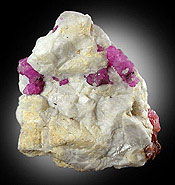Idaho Gemstone DepositsOld Mine DumpAlthough Idaho has a variety of gem mineral deposits including rock crystal and amethyst, jasper, chalcedony, agate, agatized wood, opal, garnet, aquamarine, topaz and zircon, only a few of the nationally-significant Idaho deposits are discussed in this module.
Old Mine DumpsOld mine dumps are an excellent place to search for crystal and mineral specimens. Every year weathering and erosion break down these old minewaste materials and new specimens are exposed to the view of the collector.

GarnetsGarnets occur throughout the State of Idaho in a variety of rock types, including pegmatites, garnetiferous schists and other metamorphic rocks. On the East Fork of Emerald Creek in northern Idaho, gem-quality almandite garnets are found in placer gravels of the stream bed. Almandite GarnetThese purple to red garnets are significant for the asterism or stars caused by inclusions aligned in layers. Emerald Creek garnets are formed in a mica schist by metamorphism. Through the processes of weathering and erosion, the garnets are freed from the mica schist matrix. The high specific gravity of almandite garnets allows them to be concentrated on the bedrock of Emerald Creek in placer deposits. Collectors recover this gem by digging to bedrock and using screens to recover the garnets.
Bruneau jasperChalcedonyThe most famous jasper in Idaho is the " Bruneau jasper," a red and green gem-quality stone. The Bruneau jasper deposits are, for the most part, covered by unpatented mining claims and are situated approximately 50 road miles south of Bruneau in Owyhee County.
At the Bruneau-jarbidge eruptive center, 8 to 10 large rhyolite flows fill a structural basin. These flows average about 320 feet thick and several exceed 650 feet thick.
Gas cavities are abundant in the upper zones of the rhyolite flows but are fairly uncommon in the lower zones. They range in size from small vesicles to large cavities more than three feet in diameter. Some cavities are spherical, but most are irregular due to stretching while the rhyolite was still hot and plastic. Typically, those of similar size tend to occur together in horizontal zones. Some flows have abundant cavities, whereas others are nearly devoid of them.
Fractures, gas cavities, spherulite shrinkage cavities and openings around breccia fragments serve as sites of deposition for secondary silica. Silica occurs in various forms, including opal, chalcedony and red and brown jasper. As the flow cools, silica is leached from it and then redeposited in cavities when the silica-bearing fluids cool sufficiently.
The
Bruneau jasper deposit is a zone of jasper filled sperulite shrinkage cavities. There are two small fractures in the upper zone of the Bruneau jasper rhyolite flow in the Indian Hot Springs area, The deposit which is several hundred meters across has been commercially exploited. The Bruneau jasper flow is the most silica-rich rhyolite flow in the area and is the source of silica that resulted in the predominantly red and brown jasper.
 Spencer Opal
Spencer Opal Deposit
OpalThe Spencer opal deposit is located about 5 miles east-northeast of the town of Spencer. The best access to the deposit is by driving east from Spencer on the Spencer-Kilgore county road for approximately 5 miles, then turning left (north) on a dirt road and continuing 2 miles to the mine site. Many opal prospects lie on the south side of Opal Mountain; however, most of these deposits are covered by patented or unpatented mining claims.
Opal occurs in a Tertiary-age rhyolite flow. As the rhyolite was extruded from deep within the crust, the sudden release of pressure caused gas to separate from the fluid magma and form large vesicles or cavities. The opal was later deposited in the cavities by hot water percolating through the silica-rich rocks. As the hot water moved through the rocks, it took silica into solution and then redeposited the silica as opal in the cavities and fractures.
The nodules, which are mineralized with opal, range in size from less than an inch to more than a foot in diameter. Opal occurs in the nodules as stratified cavity filling or closely-spaced layers, generally less than 0.1 inch thick. Where the silica is precipitated as microscopic spheres in an orderly arrangement, the entering light is refracted through the opal layers causing bands of "fire" with colors of green, yellow, pink, blue and red.
Opal consists of noncrystalline (amorphous) silicon dioxide (SiO2) and up to 20 percent water. The best quality opal contains less than 10 percent water. Exposure to sunlight will cause dehydration and fading of the colors. Consequently, the stone must be maintained so as to prevent water loss. Opal-filled nodules are disseminated through thick zones in the rhyolite.
Mining of the nodules is accomplished with a large dozer or by setting off small explosives. The opal-filled nodules can then be extracted by hand methods.
One of the best deposits in the area is the well known Deer Hunt Mine. The mine was reportedly discovered in 1948 by two deer hunters who were lost in a storm. The Deer Hunt Mine is open to rock hounds interested in digging the opal for a set price per pound. People from all over the world visit this mine every year to mine the popular opal gemstone.
 Corundum
CorundumCorundumThe mineral corundum is composed of aluminum oxide and is second only to diamond in hardness. Corundum occurs in a variety of colors. The transparent red corundum is the gemstone
ruby; the transparent blue variety is the gemstone
sapphire. All of the Idaho deposits of gem-quality corundum are found as placer deposits rather than in the original rock where the gems were formed. Most of these alluvial placer deposits yield dull-gray corundum which is not considered to be gem quality.
Crystals have been found at the following localities:1. Gravel bars along Rhodes and Orofino Creeks in Clearwater County near Pierce.
2. Placer deposits of the Stanley Basin in Custer County.
3. In the Gold Fork tributary of the Payette River in Valley County.
4. Between McCall and New Meadows on the headwaters of Goose Creek is a collecting area known as Rocky Flat.
Corundum concentrates in placer deposits along bedrock similar to gold and garnet because of a high specific gravity. Consequently, gem corundum is recovered in the same manner as placer gold. A screen is generally used to separate the course material containing valuable crystals from finer dirt and sand.